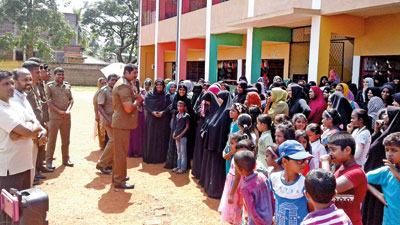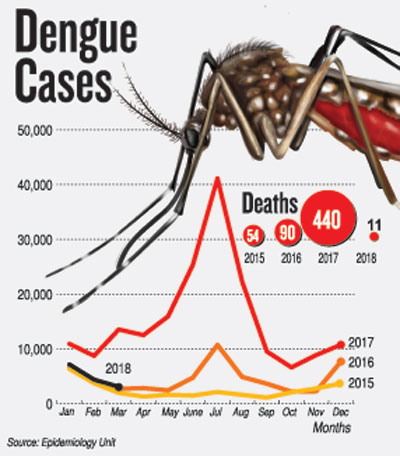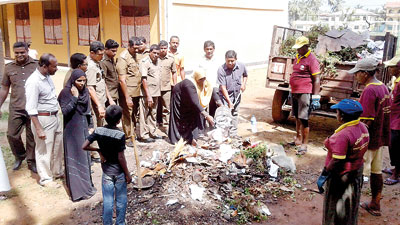News
Medicos make ready for dengue battle
As the monsoon approaches, the Ministry of Health is preparing for the dengue outbreak that accompanies the rains.

Dengue awareness campaign being conducted in Beruwala yesterday (above and below): Pix by Sarath Siriwardhana
Last week, the ministry’s Epidemiology Unit (EU) deployed 9,000 officials countrywide to check homes, schools, public places, institutions and construction sites. Health workers of the Municipal councils and pradeshiya sabhas together with army personnel and environmental police went around inspecting premises to ward off the impending dengue menace.
The number of cases of suspected dengue in the first three months of this year stands at 14,355 with 11 deaths from the disease. Last year, for the same period, 32,191 cases and several deaths were reported.
Cases increased steadily every month last year, with 82,376 in May, June and July. The problem was intense in the Western Province because of the breakdown of garbage collection by the Colombo Municipal Council (CMC). Around 5,750 cases of dengue patients came from the CMC region and 28,524 patients from surrounding areas.
With 186,101 suspected cases and 440 deaths reported countrywide, government and private hospitals were full last year, with patients having to share beds or be treated at home.
Although there was a 60 per cent drop in reported dengue cases in the January-March period this year, compared to the same period last year, the figure is up by 526 cases compared to January-March 2016.
Dr. Samarasinghe said the sharp drop in the number of dengue patients and fatalities since last year could be attributed to extensive and regular removal of mosquito breeding places, public awareness on management of garbage and public education on control of the fever.
Also, she said, type 2, a new strain, spread sporadically last year which the health sector was unable to contain. This time, although type 2 is again prevalent, the medical authorities are prepared for the outbreak. In addition, authorities are counting on the fact that people who contracted type 2 last year will now be immune to it. “It will not spread much among people,” Dr. Samarasinghe said.
The focus will be on Colombo where, as always, the figures are high – 2165 cases in the January-March period this year – a sharp drop from 7,101 cases reported in 2017.
The numbers in the north and eastern provinces have changed only slightly, with 1,107 cases reported in Jaffna and 1,471 in Batticoloa. In 2017, 1966 and 1510 cases were reported in the two districts respectively. Interestingly, in the Puttalam district there has been an increase of 374 dengue patients in the past three months.
Dr. Samarasinghe said more focus will be directed on areas with high counts or those that have not shown any improvement in numbers.



